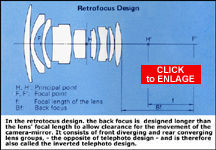|
 |
The first radical change in its lens design to suit Nikon F reflex photography was finally realized in an AUTO Nikkor-N 1:2.8 f=2.4cm lens which used revised 9 elements in 7 groups design internally and it was actually being marketed quite late in 1963. In 1975, another followed up version was released during the pre-Ai period. This version finally has a modern Nikkor feel where older cosmetic design used in previous AUTO Nikkor series of Nikkor 24mm. The version with multi-layers lens coating which has indication with an extra "C" after NIKKOR-N.C at the lens data was only being marketed quite late in 1972). |
In 1977, the Nikkor 24mm lens group has a few options for selection of lens speed. Photographers can select either Ai-spec Nikkor 24mm f/2.8 or the Nikkor 24mm f/2.0 with a faster maximum lens speed. The 24mm f/2.8 has actually went through some optical improvement during that period and formed the basis for the 1981's Ai-S-spec Nikkor 24mm f/2.8s version. By then, the Nikkor 24mm lenses have already established a good reputation for its top quality resolution and performance. Incidentally, the 24mm f/2.8 can yield one of the highest magnification ratio among all available Nikkor wideangles lenses (It delivers an astonishing magnification ratio up to 10X when use reversibly mounted on a Nikon Bellow Unit - only second to the Nikkor 20mm f/2.8s 12X !). Lastly, the AUTO Nikkor 24mm f/2.8 lens was the world's first wideangle lens for 35mm photography that employed with Close Range Correction (CRC) system. This innovative optical design has greatly enhanced performance of wideangle lenses when using them for close focusing.
NOTE: - Along with
the autofocus Nikkor optics, Nikon still offered manual focus Nikkor lenses to a
very late stage, some of the manual focus Nikkor may have been benefited from technological
development, and could have been updated with Nikon latest lens coating process of
SIC (Super Integrated Coating) from the traditional NIC (Nikon Integrated Coating).
Source:
Nikkor Club
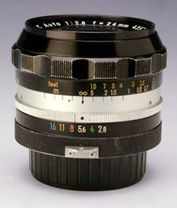 |
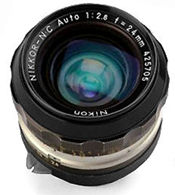 |
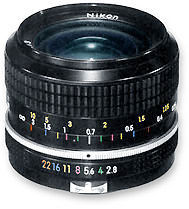 |
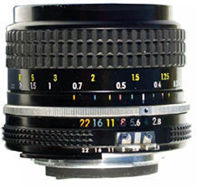 |
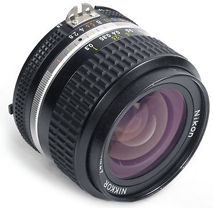 |
Generally, virtually all wideangle lenses in modern days are using retrofocus design for reflex SLR camera. A 24mm lens provides about 10° wider filed of view than the 20mm lens where generally most people regards focal length for true ultra-wideangle range begins from this focal length. It also provides about twice the image of a 35mm lens and about three times that of the 50mm lens. With a highly versatile 84° picture angle, the 24mm lens is a perfect compromise between ultra / regular wideangles - thus, it is indeed an ideal lens for a wide scope of general photographic applications. But more importantly, its wider picture angle delivers information of the subject in focus, and hence maintaining a close visual relationship of background info with the subject in focus. It is photographically an element which is useful for handling tasks such as photojournalism, documentary, reportage/news photography or even for on location portraiture. Depth of field again becomes an important element in bringing together the components within an image and due to its nature of an ultrawide angle lens, it generates extensive depth of field when stopping down the aperture; it makes out of focus a less problematic issue.
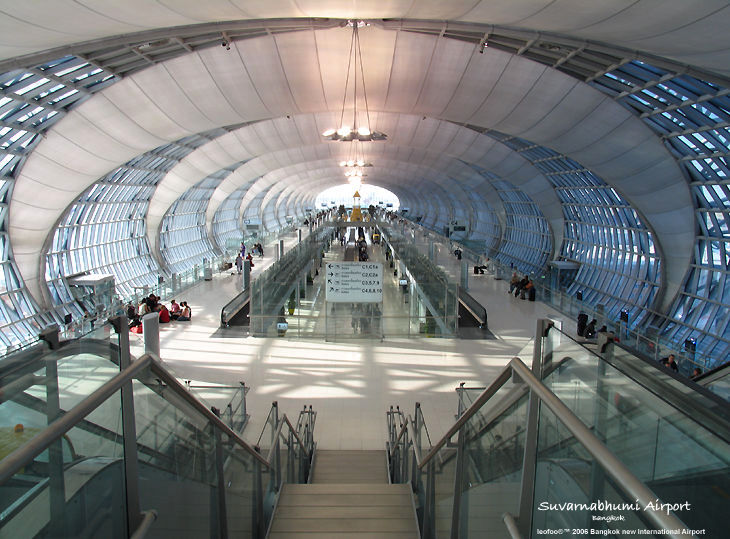 |
The departure tunnel at Thailand new Suvarnabhumi International Airport shortly after official launch, 2006 |
Nikon AF-Nikkor 24mm f/2.8s Ultra-wideangle lens
Marketed 1986; Discontinued: 1991
The autofocus version of the AF Nikkor 24mm f/2.8s fixed focal length ultrawideangle lens was released as an important component wideangle optic among the first generation of the AF Nikkor lenses because it has the widest picture angle within that group during those days. But the first version of the AF Nikkor 24mm wideangle had a weaker exterior design, which was the common issue for all those early versions of the AF Nikkor lenses. However, optically it is still delivering a comparable performance with the Ai-S spec Nikkor 24mm f/2.8s as the lens shares almost a similar optical design. Well, I guess Nikon priority during that time was simply concentrating in bringing a good, workable solution for their autofocus system. Well, although I accept the technical aspect where it may involve more issue just to package the lens now with an autofocus dressing but I don't think anyone would disagree the transitional change was done in a rush manner where the overall design of the early series of the Autofocus Nikkor lenses was way below everyone's expectation in how the autofocus version of the Nikkor 24mm wideangle should look like.
For those photographers who may be so accustomed to conventional built quality of older Nikkor lenses may feel uncomfortable with the new AF 24mm. Firstly, it has a very strong polycarbonate body structure. Although it was primarily being designed as an autofocus lens, and probably Nikon has underestimate user's responses in a time switching over to AF by not considering the needs and sentimental reason of the previous manual focus photographers. So, here we find a new 24mm wideangle that has a very strong plastic feel with a rather loose and a very narrow manual focusing ring. |
Well, during those early days of Nikon AF photography, if you wish to acquire a wideangle for your autofocus Nikon you probably may not have too many choices as with today wide range of offerings. Good news was, as all the AF Nikkor lenses were presumably all Ai-S native. Thus, the AF Nikkor 24mm f/2.8s will integrate with virtually all the exposure modes (in particular, Programmed AE and Shutter Priority AE) across the entire line of Nikon AF/MF SLRs available during that time. Secondly, minus the discomfort on the exterior poor built quality, internally the lens are still retaining the same 9 elements in 9 groups with CRC optical design inherited from the manual focus 24mm. So, if you are confident how old MF lens can deliver for your photography, it was simply the same lens with equaling performance, further aided with an autofocus mechanism for the autofocus Nikon, that is all.
In general, the AF 24mm f/2.8s can be a very useful wideangle lens for a wide scope of photographic usage. As most wideangle lenses generates extensive depth of field which makes pre-focus a common practice. As long as the used aperture is a smaller number, the extended depth of field of a 24mm lens should provide safe coverage. This lens has 3 marked depth of field scales (f/11, f/16 and f/22) for you to refer where for practical reason, I do wish Nikon could added another one or two frequently used mid apertures such as f/5.6 or f/4.0 being added onto. Why ? because NOT all Nikon SLR bodies offer depth of field preview function and lens aided visual guide can be incredibly useful. Most higher spec Nikon models such as Nikon F4 , F801(s) or the Nikon F90(x) do provide this feature but some entry models that began to surface after early '90 were omitting this feature. Well, I am not asking Nikon to deliver us again with those colorful DOF visual printed onto lens as with those found on the manual focus lenses, but it offers convenience and help to a responsive reaction during shooting without activating another lever or button to check depth of field.
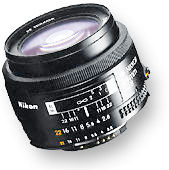 |
Theoretically, the AF Nikkor 24mm f/2.8s will work with a AF-Tele Converter TC-16A to enable the lens multiplies the focal length by a factor of 1.6X or use it with a conventional Teleconverter such as Nikon TC-200 or TC-201s but such combination will revert the autofocus lens back to manual focus. On a practical note, it makes not much sense to do so as it will multiplying the primary focal length to an approx. 48mm standard lens range. Besides, the primary objective of why people buy an autofocus 24mm wideangle is because it autofocus - but not manual focus. So adding a TC and going back to MF is simply not a wise thing to do even if such possibility exists, right ? |
Together with the current version of AF-D - they are all together 3 versions of the AF Nikkor 24mm f/2.8s being introduced so far. The minimum aperture lock for the FIRST version here used a twisted knob design where you can use it as a easy way to distinguish it from the next upgrade. It took Nikon 5 years to think of a upgrade for this original 24mm wideangle, along with the AF Nikkor 28mm f/2.8s and AF Nikkor 50mm f/1.4s, Nikon provided a lens update for the first version of the AF 24mm wideangle lens in 1991. Some Nikon folks referred them as "N" or "New" i.e. AF Nikkor 28mm f/2.8N or AF Nikkor 50mm f/1.4N. Here, I am using the term Mark I, Mk II, MK III to differentiate the version number. It doesn't really matter, as they are just a way to interpret the version history.
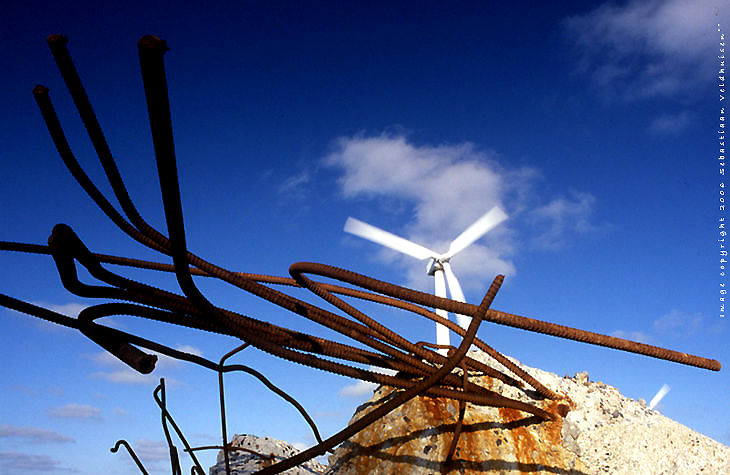 |
Credit: Image courtesy of Sebastiaan Veldhuise, whose online PORTFOLIO can be accessed at PBase. Image copyright © 2006. All rights reserved. Please respect the visual property of the contributing photographer. |
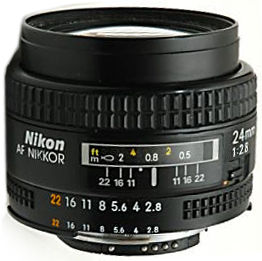 |
Nikon AF-Nikkor 24mm f/2.8N (Mk II) ultra-wideangle lens |
In operation, the AF Nikkor 24mm f/2.8S auto/manual focusing as well as providing focus assist feature with compatible Manual Focus Nikon SLR bodies. The Close Range Optical Correction System has helped to maintain its high quality optical quality to be extended all the way down to its minimum focus distances. In this respect, I am not particularly sure if the lens can still be used with a Nikon Auto Bellow in reversible position to achieve the astonishing high magnification ratio of up 9X as with the manual focus counterpart. Compact and lightweight, this second version of the AF Nikkor 24mm f/2.8S fit into everyone budget as a truly high performance fixed focal length ultra wideangle lens. Weighing almost similar to the AF predecessor at 8.9 oz. and measuring merely 3.5" in length, this provides excellent portability factor for anyone that prefers traveling light. It has a 52mm filter attachment size, making it easy sharing with other 52mm standard filter accessories. Lastly, as this version of the AF Nikkor 24mm f/2.8N (Mk II) was only short lived between 1991 to 1993 and possibly only smaller quantity has been sold to the market during that time, as evidenced by most of the used units that kep surfacing at EBAY are of the original version.
![]()
Technical
Specification
for AF Nikkor 24mm
f/2.8s; applicable
to AF Nikkor 24mm
f/2.8N (MK II) ultra-wideangle lens:-
Type of lense: Autofocus Nikkor fixed focal lens with built-in CPU and Nikon
bayonet mount
Focal length: 24mm; Maximum aperture: f/2.8; Minimum Aperture:
f/22
Lens construction: 9 elements in 9 groups with CRC, floating lens elements
for close focusing
Picture angle: 84° (35mm); 64° Nikon DX digital SLR format cameras
(magnifies as approx. 48mm)
Diaphragm: Fully automatic,
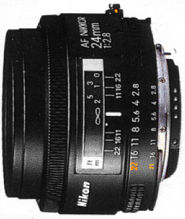 |
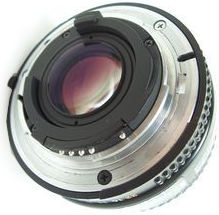 |
Distance scale: Graduated in meters and feet/inches from 0.3m (1.0') to infinity (OO) |
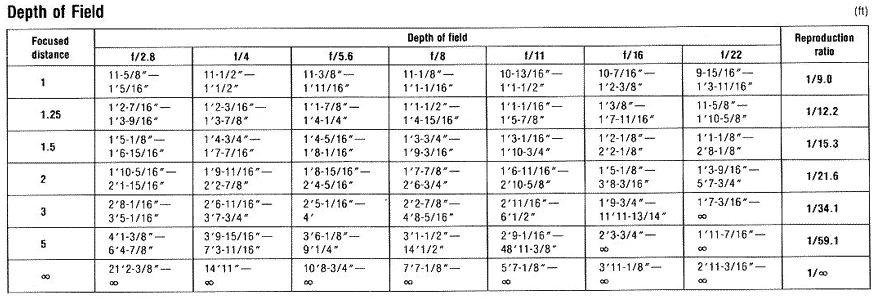
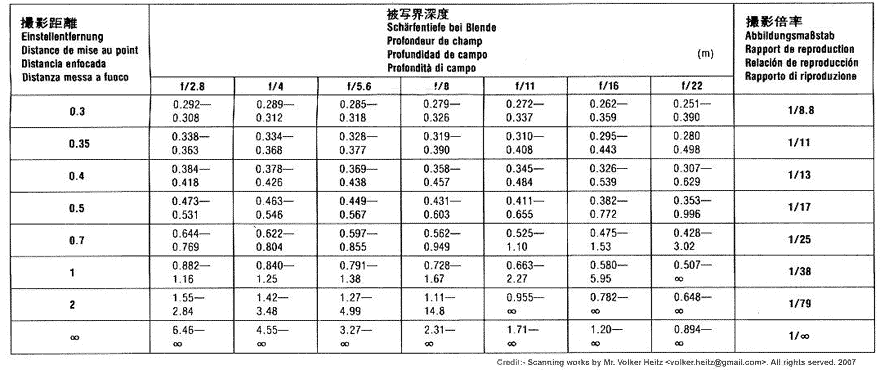
Lens Coating:
NIC (Nikon Integrated Coating)
Exposure measurement: Via full-aperture method for Ai cameras or cameras with
CPU interface system
Mount: Nikon bayonet mount with CPU contacts; Attachment size: 52mm
(P=0.75mm)
Standard accessories: 52mm Snap-On front lens cap; Rear lens cap LF-1; Hard
lens case: the newer CL-30S Usable (Optional)
Optional Accessories: 52mm screw-in filters, Screw-in lens hood HN-1 metal
hood(optional)
Dimensions: Approx. 2.5" dia. x 1.8"; Weight: Approx. 8.9
oz.
Usable
Tele-Converters: - TC-201S; TC-14A (meaningless to do so).
Lens case:
CL-30s, CL-34A, No. 61 soft pouch, or CP-8 plastic
Others:
AF 24/2.8 plastic focus
ring, twist aperture lock 200001 < 203265 - 255739 > Sep86 - Jun91
AF 24/2.8 New (MK II) with rubber manual focus ring, slide aperture lock < 310828
- 348471 > Jun91 - Sep94. Reference:
Roland Vink's lens data sheet.
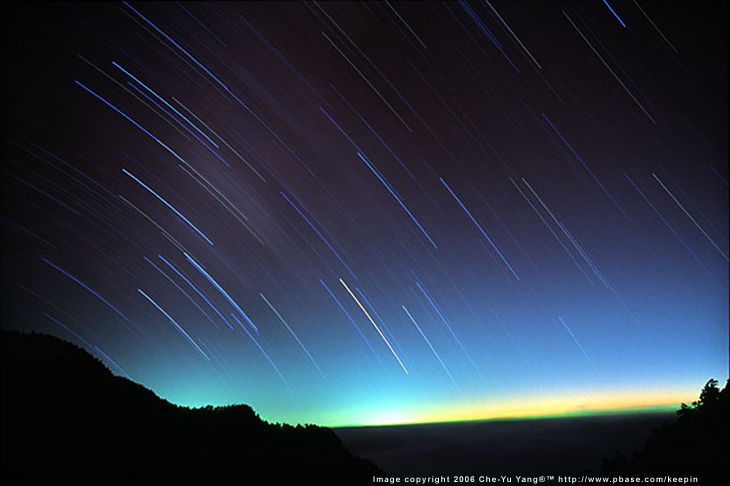 |
Astro photography.. |
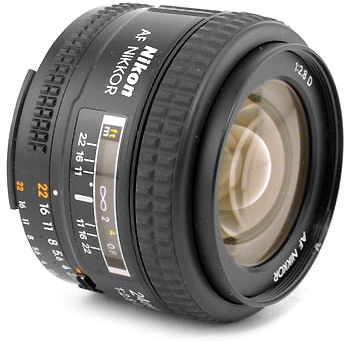 |
Nikon AF-Nikkor 24mm f/2.8D ultra-wideangle lens |
Perhaps Nikon has a lot of pride with the original optical design used in the 24mm wideangle lens because optically it was still adopting the same optical formula of 9 elements in 9 groups that actually first used for the manual focus Ai Nikkor 24mm f/2.8 in the late '70. So, internally, this AF-D was also using the same optical formula all along with the previous versions. Well, to quote the lens is exactly the same with the predecessor may not be a little too conclusive. This is a D-spec Nikkor, you can simply verify the version via the "D" added after the lens designation. The lens has been slightly re-designed with a slightly rounded edges as well as the lens barrel section has been coating with a layer of resin which contribute to its better and more rigid appearance. Somehow, It works and restores an overall quality feel.
Well, sometimes you may wonder why amidst all the available options of high performance zoom lenses with this 24mm focal length covered and yet there are photographers prefer going back to use a fixed focal length optic. I would think performance, practicality, portability and affordability are the key elements in enabling a lens to enjoy an evergreen status. Recently, a friend has left me with his price possession of a Nikon D2X with an AF-S Zoom Nikkor 17-35mm f/2.8D ED-IF lens attached; with a combined weight of nearly 2kg (745g and 106mm in length for lens itself); I find you ought to be physically fit and technologically sound to be a modern photographer today as other than w weight factor, there are also a long series of mind boggling controls and buttons to mater. Come to think of it, do yourself need to be fully gear just to handle a casual shot ? Many may be but I am not and I guess this common philosophy could has been shared by many others. Personally, I still favor shooting in the light and easy manner and the last thing in my mind during photography is to struggle with the gears I use. This lens makes a good companion for photographer who prefer travel in the lightest possible package Its superlative optical performance has created many following over the years and for those who love to maximize potential of their autofocus film/digital Nikon SLR cameras, this lens makes a perfect match to serve this kind of needs. I am not so particularly sure if Nikon will replace this lovely wideangle lens with an aperture-ring-less G spec version in the future but I guess it is highly unlikely as one way or another, the big pool of market users who may have bought older Nikon bodies are still hard to be ignored by Nikon commercially.
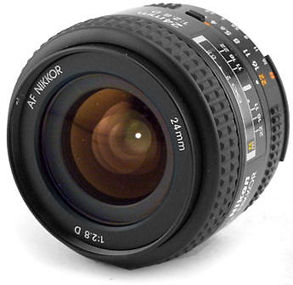 |
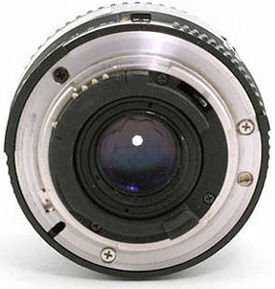 |
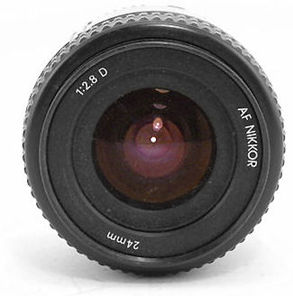 |
Credit: All Image(s) of this AF-D Nikkor wideangle lens courtesy of 'Shutterblade team' (e-mail) who specializes trading of new, used collectable cameras. The Company also operates a popular Ebay Store. All image(s) appeared herein are Copyright © 2005. All rights reserved. Please respect the visual property of the contributing photographer.
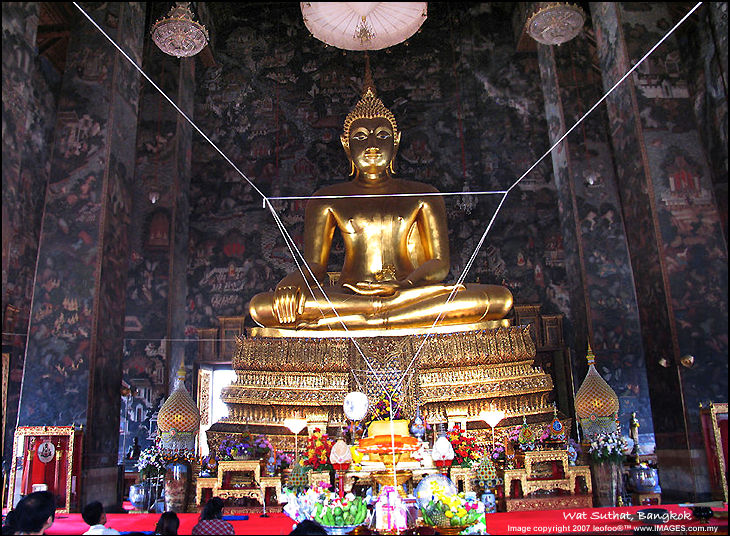 |
The peacful ambience inside the at the Viharn of this 1807 A.D. built Wat Suthat Buddhist temple in Bangkok with the Phra Sri Sakayamuni Buddha image at the center. I retained a few pilgrims at the bottom to show its magnifient scale. |
![]()
Technical
Specifications
for AF-Nikkor
24mm f/2.8D ultra-wideangle lens:-
Type of lense: Autofocus primary; manual focus possible; Nikkor fixed focal
lens with built-in CPU
Focal length: 24mm; Maximum aperture: f/2.8; Minimum Aperture:
f/22
Lens construction: 9 elements in 9 groups with CRC floating lens elements
for close focusing
Picture angle: 84° (35mm); 64° Nikon DX digital SLR format cameras
(approx. 48mm based on 1.5 lens factor)
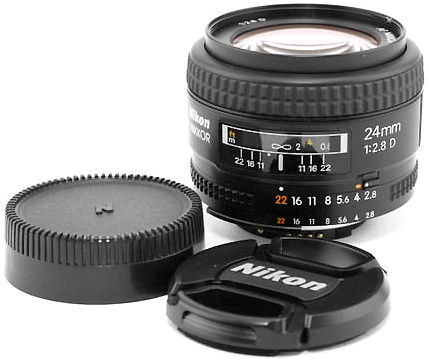 |
Distance scale: Graduated in meters and feet/inches from 0.3m (1 ft) to infinity (OO) |
Mount: Nikon bayonet mount; Attachment size: 52mm (P=0.75mm)
External front filter attachment frame: Does not rotate
Standard accessories: 52mm Snap-On front lens cap; Rear lens cap LF-1 (newer or older ones usable);
Optional Accessories: 52mm screw-in filters, Screw-in lens hood HN-1 metal lens hood (optional)
Dimensions: Approx. 64.5mm (2.5") dia. x 46mm (1.8")
Weight: Approx. 270g (9.3 oz.)
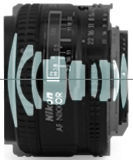 |
 |
Usable Tele-Converters: -TC-201S; TC-14A (similarly meaningless to do so; unless force to do so). |
Others: Production Serial Numbers believed to have started from 400001 for this AF-D Nikkor wideangle lense <400001 < 401331 - 488042 > > > - Roland Vink's lens serial numbering data sheet.
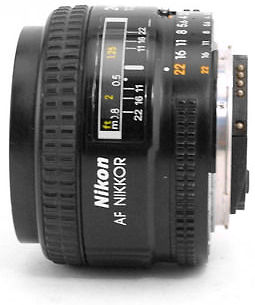 |
| NEXT | AF Nikkor 28mm wideangle lenses |
Main Index Page - Autofocus Nikkor lenses
| Message Board |
for your
Nikkor
Optics
in a shared environment
| Message Board | Specifically for Dispose or Looking for new/used Nikon/Nikkor photographic equipment
| Nippon Kogaku Rangefinder Resources | Nikon F | Nikon F2 | Nikon F3 | Nikon F4 | Nikon F5 | Nikon F6 | Nikkormat / Nikomat | Nikon FM Series | Nikon FE/ FA | Nikon EM/FG/FG20 | Nikon Digital SLRs | Nikon - Other models |
Nikon MF RF-Nikkor lenses for Rangefinder
cameras:-
Main Index Page
Nikon
Auto Focus Nikkor lenses:- Main Index
Page
Nikon
Manual
Focus
Nikkor lenses:-
Fisheye-Nikkor Lenses - Circular |
Full Frame |
Ultrawides Lenses - 13mm15mm18mm20mm |
Wideangle Lenses - 24mm28mm35mm |
Standard Lenses - 45mm 50mm 58mm | Telephoto Lenses
- 85mm105mm135mm180mm & 200mm |
Super-Telephoto Lenses - 300mm 400mm 500mm 600mm 800mm 1200mm |
 |
Special Application
lenses: Micro-Nikkor Lenses - 50mm~55mm -60mm 85mm -105mm 200mm Micro-Zoom 70-180mm Perspective Control (PC) - 28mm 35mm PC-Micro 85mm Dedicated Lenses for Nikon F3AF: AF 80mm f/2.8 | AF 200mm f/3.5 EDIF Depth of Field Control (DC): 105mm 135mm Medical Nikkor: 120mm 200mm Reflex-Nikkor Lenses - 500mm 1000mm 2000mm Others: Noct Nikkor | OP-Nikkor | UV Nikkor 55mm 105mm | Focusing Units | Bellows-Nikkor 105mm 135mm Nikon Series E Lenses: 28mm35mm50mm100mm135mm | E-Series Zoom lenses: 36~72mm75~150mm70~210mm |
MF Zoom-Nikkor Lenses: 25~50mm | 28~45mm | 28~50mm | 28~85mm | 35~70mm | 36~72mm E | 35~85mm | 35~105mm | 35~135mm | 35~200mm | 43~86mm | 50~135mm | 50~300mm | 70~210mm E | 75~150mm E | 80~200mm | 85~250mm | 100~300mm | 180~600mm | 200~400mm | 200~600mm | 360~1200mm | 1200~1700mm
Tele-Converters: TC-1 | TC-2 | TC-200 | TC-201 | TC-300 | TC-301 | TC-14 | TC-14A | TC-14B | TC-14C | TC-14E | TC-16 | TC-16A | TC-20E
Recommended links to understand more technical details
related to the Nikkor F-mount and production Serial Number:
http://rick_oleson.tripod.com/index-153.html by: my
friend, Rick Oleson
http://www.zi.ku.dk/personal/lhhansen/photo/fmount.htm by: Hansen,
Lars Holst
http://www.mir.com.my/rb/photography/hardwares/nikonfmount/lens2.htm
http://www.photosynthesis.co.nz/nikon/serialno.html
Recommended Reading Reference on Nikon cameras and Nikkor lenses | about this photographic web site
| | Back | Main Index Page of Nikkor Resources | Back | Main Index Page of Pictorial History of Nikon SLRs |
| Home - Photography in Malaysia |
![]()
Credit: To all the good
people who has contributed their own experience, resources or those who are kind
enough granting us permission to use their images appeared in this site Note:certain
content and images appeared in this site were either scanned from official marketing
leaflets, brochures, sales manuals or publications published by Nikon over the years
and/or contribution from surfers who claimed originality of their work for educational
purposes. The creator of the site will not be responsible for may discrepancies arise
from such dispute except rectifying them after verification."Nikon", "Nikkormat", "Nippon Kokagu
KK"
& "Nikkor" are registered
tradename of Nikon Corporation Inc., Japan. Site made with an Apple IMac.

